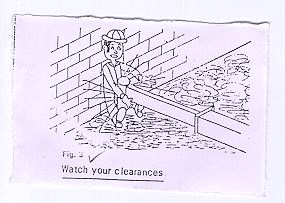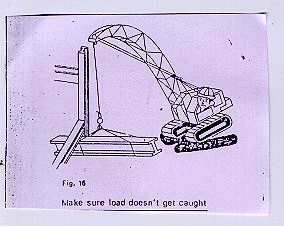Contents
Mobile crane safety
Common Failures in Cranes:-
Types of Error in operating cranes
- 1) Human Error.
- 2) Machine Error.
- 90% of failure occur due to human error.
- The failures that occur due to human error for the following unsafe practices.
SAFETY IN USE OF MOBILE CRANES / operating cranes
Watch Your Clearance during operating cranes
- Clear work area.
- Proper clearance from m/c, boom or load.
- Vision should not be obscured.
- Blow horn to signal or warn.
- Understanding of signals.
Daily Inspection of Machine during operating cranes:-
- Don’t operate a poorly maintained m/c.
- Inspect clutches, brakes, attachments & wire rope daily.
- Lattice boom check.
REMEMBER during operating cranes “PARTS ARE CHEAPER THAN PEOPLE”
Don’t let the load hit the boom during operating cranes:-
- Don’t let the boom rest on or hit against an object.
- If a lattice or diagonal bracing member is broken or cracked, REPLACE IT.
- If bent straightens it.
SAFETY IN USE OF OPERATING CRANES
Working near power lines:-
- Be alert – you are working around a condition which can cause death.
- keep all m/c parts, hook block & load, fall lines – at least 15feet from Line.
- Assume that every line is hot.
- Appoint a person with a loud signal to warn the operator.
- Don’t allow anyone to lean against or touch the m/c.
- Don’t allow sling man or load handlers to hold load or rigging gears unless necessary.
- If m/c operating in arc zone, keep moving away from the line until arc breaks at least 15 feet away.
- If disengagement from the line is not possible & m/c is not on fire, stay back in the seat until power line shut off.
- If leaving from the m/c is must, leap from the m/c as far as you can.
Use of magnet for lifting:-
- Lifting magnet generators produce voltages in excess of 200 volts & present an electrical shock hazard- deploy trained personnel.
- Don’t touch magnet or load while in operation.
- Don’t let workmen get in between magnet & metal object.
- If necessary to position a load, use a dry, wooden stick.
Operating cranes
Crane boom safety:-
- Loads must be well secured before lifting.
- Chains & slings must be of adequate size.
- The load must not catch on an obstruction when lifting or swinging.
- Avoid sudden starts & stops, Operate smoothly.
- Never wrap the hoist around the load during operating cranes. Never use discarded, worn, or damaged rope for slings
- The m/c must be level before making a lift. The hook block and fall lines can be used as plumb bob for leveling.
- Remember -a 3-degree side tilt can reduce the cap. By 50% or more.
Know your load:-
- Use a scale weight, carefully calculated weight or hook scale or a load indicating system
- Weight includes the weight of slings, gear, hook block & any overhaul weights.
- In case of lifting with fly jib installed, the weight of the jib & rigging mast must also be considered part of the load.
- The total weight should never exceed the rated capacity of the m/c.
- Avoid operating an m/c in high winds & wind blowing against the load, as it produces side load on boom & reduces capacity.
- Keep the load lines as short as possible.
Effect of centrifugal force:-
- Centrifugal force tends to increase load radius. This increase in load radius could overload the machine & cause damage. Use of tagline is recommended to control this force.
Crane boom safety during operating cranes:-
- Operating on the outrigger, beams must be fully extended as well as, so that tyre is clear of grounds.
- Do not pick loads on the main hoist and jib at the same time.
- Do not work with jib angles greater than 30deg w.r.t. boom.
- Do not increase the counterweight above than specified.
- Avoid using multiple cranes on a lift.
- Use caution when operating with minimum radius. This may damage boom backstop.
- After slack rope operation, make sure rope is properly seated on sheaves & drums.
- Never lower the boom on load beyond the point where two full wraps of load are left on the drum.
Submerged load:-
- Caution while lifting the Submerged load
- It may be saturated & weigh much time more than is expected.
- Should be raised slowly
Never stand in front of the Tyre when inflating
Battery & Radiator:-
- Never use an open flame to check a battery
- Be careful when removing radiator caps.
Types of failures in EOT Cranes:-
- Uncontrolled long/cross travel due to the negligence of the operator.
- Provide limit switch strikers to avoid derailment.
- Provide mechanical impact buffers to prevent unexpected travel.
- Lightweight small objects hindrance on rails:
- Provide skurt boards in the front and rear side of bogies to push away the hindrance.
- Over hoist protection:
- Provide a pendent limit switch to prevent over hoist.
- Short circuit :
- Provide waterproof operator cabin & guard all electrical components.












Very thorough article considering there not a lot of topics like this. This is the most informative. thanks!
Your article is quite helpful! I have so many questions, and you have answered many. Thank you! Such a nice and superb article, we have been looking for this information about safety in use of mobile cranes. Great post…
This is a very informative blog, thanks for sharing about these safeties in use of mobile cranes. It will help a lot; these types of content should get appreciated. I will bookmark your site; I hope to read more such informative contents in future… great post!!
Thanks a lot to you for sharing about safety in use of mobile cranes here, these kind of ideas are were much needed. I really appreciate that you have provided the data too, really appreciative and useful blog for us. Looking for more!!
It’s interesting to know how much voltage is generated when using a magnet to lift things using a mobile crane. I think I would be needing to hire a crane in order to speed up the building of my house. Even if not the magnetic variant, I think getting the roofing done before the rainy season would be a sound decision and would surely make the worker less tired due to less hauling of materials around the site.
Good work, as always.
Thanks for making me aware that it’s important for cranes to be at least 15 feet away from power lines while they are lifting something. I’m currently planning to have my air conditioning system replaced with a less bulky unit than my old one, but since I’ll need to take away the other unit from my rooftop, I’ll need to have it lifted away first. I suppose I can hire a service to help me out with that task since the unit weighs almost a quarter of a ton.